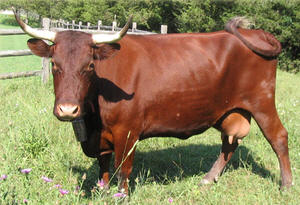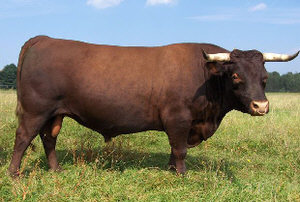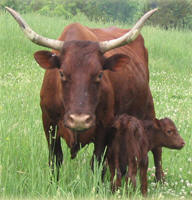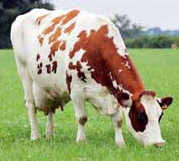



Milking Devon
History
The Milking Devon has been bred (in the USA) from the Devon which originated in Britain that is supposed to be descended from the same aboriginal breed as the Hereford and the Sussex.In 1623, two heifers and a bull from north Devonshire, England, were received by a member of the Plymouth Colony. They were the first importation of cattle from Britain, although the Spanish had introduced cattle in the south. Their immediate value was as draft animals. Cattle from Devonshire had long been recognised in England for their speed, intelligence, strength, willingness to work, and ability to prosper on course forage, in a wide range of climates.
In later years, other cattle were imported and contributed to the American Devon, which developed as the ideal multipurpose breed. None could surpass it for draft work; the milk was good for cream and cheese making; and the carcass developed fine beef on poor forage.
In more recent times, the importance of cattle for draft animals has all but disappeared and the Devon has been replaced by high producing dairy breeds like the Holstein and Jersey, with whom it could not compete for quantity.
In 1952, the American Devon Cattle Club decided that the breed had to move into a specialist beef market in order to survive.
At that time, a small group of breeders decided to form a separate association for dairy cattle and maintain triple-purpose stock. That association slowly dwindled, but thanks to their efforts, many of their animals can be traced into the new registry which was reformed in 1978. This registry represents a gene pool of genuine triple-purpose cattle able to survive and be productive under minimal management conditions in a harsh environment.
Characteristics
 Photo courtesy of Devon Point Farm, www.devonpointfarm.com |
The Devon cow is especially elegant with her compact rounded form, and when treated with kindness, possesses a docile temperament. They have very few calving difficulties and adequate milk production to raise a calf and for use on the small farm. The Devon bull is noted for his ease of handling and even temperament.
The Milking Devon is a triple-purpose breed adapted to survive on a low-quality, high forage diet under severe climatic conditions. They are healthy, long lived, and thrive on good care and management.
Today, Devons are still sought out for use as oxen. Those qualities so highly prised by the colonists can still be found in today's Devons.
The Milking Devon produces Jersey-quality milk, without the Jersey’s dependence on grain. Milk production depends a lot on feed of course. Butterfat and protein numbers in Milking Devons are high, in the same range as the Jersey and the Guernsey. Butterfat of 6% or higher is common.
Milking Devons tend to have small calves, resulting in calving ease; yet because the Milking Devon cow produces high-component milk in moderate volume, she weans a proportionately large and fat calf. Because she readily adjusts to demand (whether that be a sucking calf, or milking, or both) she typically conserves condition and breeds back on time.
 Photo courtesy of Wiseacre Farm, www.milkingdevons.com |
Milking Devon steers, heifers, bulls and dry cows fatten easily. The Milking Devon is a good choice for grassfed beef with zero grain supplementation, because of the breed’s extraordinary efficiency converting forage into growth and marbling. A dress-out percentage of 60% is reasonable in steers of balanced breeding.
The Milking Devon steer marbles with greater ease and under less favorable conditions than most other cattle breeds. The fat is an attractive creamy white.
When kept solely for cow-calf beef production, the Milking Devon cow does not require stripping when fresh even though she lactates generously; she easily adjusts her milk volume to meet demand. This natural flexibility is another factor favouring the Milking Devon for straight beef, dairy/beef or even once-per-day milking programs.
Milking Devon cows gain condition easily. This means that after a summer on pasture alone it is possible for the herd to winter on hay, stockpiled hay and/or grass silage, and still have reserves for spring calving and freshening.
Milking Devon steers gain as much weight in winter on dry hay, as they did when grazing intensively rotated perennial pastures during the previous season.
Statistics
 Photo courtesy of Devon Point Farm, www.devonpointfarm.com |
- Early maturing
- Better adapted to warm latitudes
- Noted rather for the quality than the quantity of their milk suited to butter and cheese making
- Flesh evenly and smoothly hence they are not given to patchiness
- The meat is nicely veined and marbled, and is well flavoured, juicy, and of prime quality
- Easy-keeping, rugged vitality
- Longevity
- Excellent fertility and maternal performance
- Intelligence and mild temperament
- Agility and endurance
- Diverse forage palatability
Comparative
Distribution
The Milking Devon strain is unique to America and has been maintained and is represented by the American Milking Devon Cattle Association.References (the above information was cited from the following sites)
www.milkingdevons.org
www.milkingdevons.com
www.devonpointfarm.com


